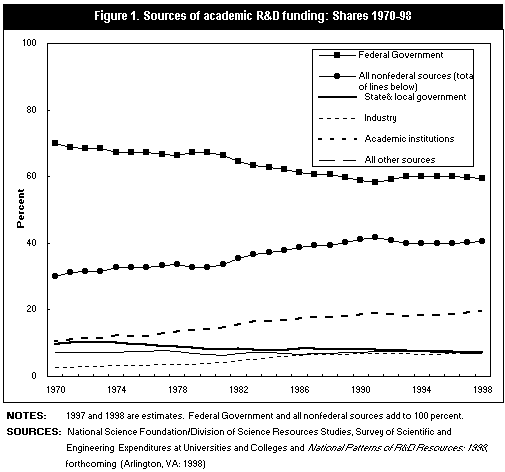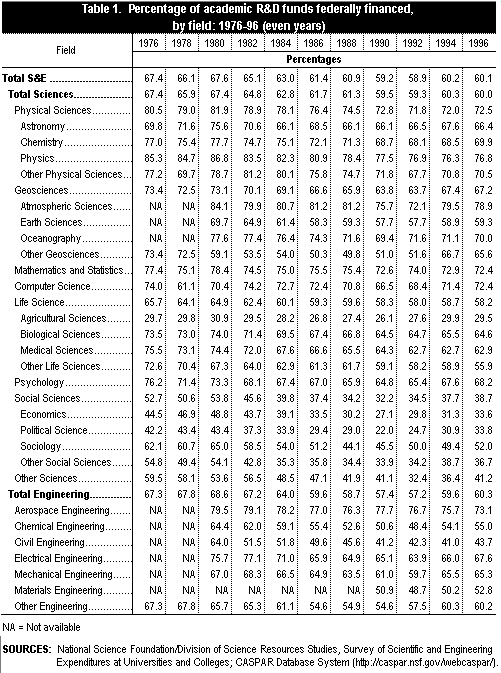
Directorate for Social, Behavioral
and Economic Sciences
NSF 99-317 December 23, 1998

The federally financed share of academic R&D had been declining during the 1970s and 1980s but stabilized at around 60 percent in the 1990s.
Although industry R&D support to academia grew faster than funds from any other source, industry accounts for only 7 percent of the total.
Adequate financial support for research and development (R&D) activities at U.S. universities and colleges is essential in enabling academic researchers to carry out world-class research. Such support comes from a number of sources whose relative contribution has been changing over the past several decades. Changes in support patterns tend to raise concern in the academic science and engineering community about potential impacts on overall academic R&D activities. This Issue Brief focuses on the main sources of financial support for academic R&D and the changes that have taken place over the past two decades.[1]
Overall Sources of Support
The Federal Government provides the majority of funds for R&D performed in academic institutions.[2] In 1998, it accounted for 59 percent of the estimated funding for academic R&D. The federally
financed share had been declining fairly steadily from 1970 until the beginning of the 1990s, dropping from 70 percent in 1970 to 58 percent in 1991. Since then, it has fluctuated between 59 and 60 percent (figure 1).

Institutional funds[3] constitute the second largest source of academic R&D funding. The major sources of institutional R&D funds are (1) general-purpose state or local government appropriations, particularly for public institutions; (2) general-purpose grants from industry, foundations, or other outside sources; (3) tuition and fees; (4) endowment income; and (5) gifts that are not restricted to research by the donor. Other potential sources of institutional funds are income from patents or licenses and income from patient care revenues. The share of support represented by institutional funds has been increasing fairly steadily since 1970. In that year, institutional funds accounted for about 11 percent of all academic R&D expenditures; the estimated 1998 share is just over 19 percent.[4]
The share of academic R&D funding provided by state and local governments declined from 10 to 8 percent between 1970 and 1980, stayed around the 8 percent level between 1980 and 1991, and declined further during the 1990s, nearly reaching an estimated 7 percent in 1998. This share, however, only reflects funds directly targeted to academic R&D activities and does not include general-purpose state or local government appropriations that may be used for separately budgeted research or to cover unreimbursed indirect costs or cost sharing. Consequently, the actual contribution of state and local governments to academic R&D will be understated, particularly for public institutions.
The funds provided for academic R&D by the industrial sector grew faster than did funding from any other source during the past three decades, although they still account for one of the smallest shares of funding. Industry increased its share from slightly below 3 percent in 1970 to about 4 percent in 1980 and about 7 percent in 1990, where it has remained since. Industry's contribution to academia represented an estimated 1.3 percent of all industry-funded R&D in 1998, compared to 0.8 percent in 1980 and 0.6 percent in 1970. However, this relative contribution has not grown since 1994.[5]
Other sources of support include grants for R&D from nonprofit organizations and voluntary health agencies, gifts from private individuals that are restricted by the donor to research, and all other sources restricted to research purposes and not included in the other categories. This source of academic R&D support has stayed fairly constant at about 7 percent during the past three decades.
These various funding sources often have different research priorities. The Federal sector primarily supports basic research at academic institutions—72 percent of its estimated 1998 funding went to basic versus 20 percent to applied research. Nonfederal sources, on the other hand, provide a somewhat larger share of their estimated 1998 support for applied research (63 percent for basic and 30 percent for applied research). As a consequence of this differential emphasis, 63 percent of the basic research performed at universities and colleges is supported by the Federal Government while only 49 percent of the applied research is so supported.[6]
Sources of Support by Broad S&E Field
The distribution of Federal and nonfederal funding of academic R&D varies by science and engineering (S&E) field[7] (table 1). In 1996, for example, the Federal Government financed
close to 80 percent of academic R&D expenditures in both physics and the atmospheric sciences; and about 70 percent in chemistry, oceanography, mathematics and statistics, the computer sciences, psychology, aerospace engineering, and electrical
engineering. In contrast, it supported only 34 percent of academic R&D in economics and political science and 30 percent in the agricultural sciences. The declining Federal share in support of academic R&D over the past couple of decades is not
limited to particular S&E disciplines. Rather, the federally financed proportion of support for each of the broad S&E fields was lower in 1996 than in 1976 (table 1). The most dramatic decline occurred in the social
sciences (53 percent in 1976 versus 39 percent in 1996); the smallest decline was in the computer sciences (74 to 72 percent). The long-term decline also holds for most of the more detailed S&E fields, with a fall in share by more than 10 percent
for the earth sciences, medical sciences, economics, sociology, and civil engineering.[8] However, many of these fields have experienced slight increases in Federal share during the first half of the
1990s.

This Issue Brief was prepared by:
Alan I. Rapoport
Division of Science Resources Studies
National Science Foundation
4201 Wilson Boulevard, Suite 965
Arlington, VA 22230
703-306-1776 ext. 7208
E-mail: arapopor@nsf.gov
SRS data are available through the World Wide Web (http://www.nsf.gov/statistics/). For more information about obtaining reports, contact pubs@nsf.gov. or call (301) 947-2722. For NSF's Telephonic Device for the Deaf, dial (703) 306-0090. In your request, include the NSF publication number and title, your name, and a complete mailing address.